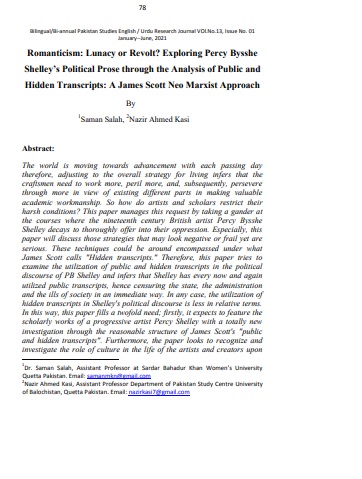Romanticism: Lunacy or Revolt? Exploring Percy Bysshe Shelley’s Political Prose through the Analysis of Public and Hidden Transcripts: A James Scott Neo Marxist Approach
Keywords:
PB Shelley‟s Political Prose, James Scott Neo Marxist Approach, Public and Hidden transcripts.Abstract
The world is moving towards advancement with each passing day
therefore, adjusting to the overall strategy for living infers that the
craftsmen need to work more, peril more, and, subsequently, persevere
through more in view of existing different parts in making valuable
academic workmanship. So how do artists and scholars restrict their
harsh conditions? This paper manages this request by taking a gander at
the courses where the nineteenth century British artist Percy Bysshe
Shelley decays to thoroughly offer into their oppression. Especially, this
paper will discuss those strategies that may look negative or frail yet are
serious. These techniques could be around encompassed under what
James Scott calls "Hidden transcripts." Therefore, this paper tries to
examine the utilization of public and hidden transcripts in the political
discourse of PB Shelley and infers that Shelley has every now and again
utilized public transcripts, hence censuring the state, the administration
and the ills of society in an immediate way. In any case, the utilization of
hidden transcripts in Shelley's political discourse is less in relative terms.
In this way, this paper fills a twofold need; firstly, it expects to feature the
scholarly works of a progressive artist Percy Shelley with a totally new
investigation through the reasonable structure of James Scott's "public
and hidden transcripts". Furthermore, the paper looks to recognize and
investigate the role of culture in the life of the artists and creators upon
their utilization of either public or hidden transcripts. The paper
concludes that Shelley being the child of a parliamentarian was not
uneasy to utilize public transcripts in his artistic works. This may be his
significant reason for being a radical writer in its beautiful substance and
structure.
References
Barnefield, G. (1925). The Psychology of the Poet Shelley. London,
England: Oxford Publication.
Bean, J.C. (1974). The Poet Borne Darkly: The Dream-Voyage Allegory
in Shelley's Alastor. Keats-Shelley Journal, 23(1), 9.
Burns, A. J. D. (2004). Sweet Degradation: The Persistence of the Gothic
in Shelley's Representations of Love (Doctoral
Dissertation). The University of Leeds, YorkShire,
England.
George, Hendrick. (1977). Henry Salt, Humanitarian Reformer and Man
of Letters. Illinois: University of Illinois Press.
Gilmour, Ian. (2002). The Making of the Poets: Byron and Shelley in
Their Time. New York: Carrol and Graf Publication.
Guertin, M. (1977). Shelley's Poetic Inspiration and its Two Sources: The
Ideals of Justice and Beauty (Master‟s Thesis). Ottawa,
Canada.
Kurtz, B. P. (1933). Introduction to the Complete Poetical Works of Percy
Bysshe Shelley. England: Oxford University Press.
Liberto, F. (2010). The Politics of Language in P.B. Shelley. La Questione
Romantica, 2(1), 56.
MacEachen., Dougald, B. (2011). CliffsNotes on Shelley's Poems.
Retrieved From www.cliffsnotes.com.
Miller, Susan. (2013). Shelley‟s Early Fiction in Relation to his Poetics
and Politics: an Assessment. Not Waiting to See the
Event of his Victory (Doctoral thesis). University of
Glasgow, England.
O‟Neill, M. (1980). A critical Study of the Relationship between Style and
Vision in Shelley‟s Poetry (Doctoral dissertation). Oxford
University, Exeter College, England.
Peck, W. E. (2003). Shelley: His Life and Work 1792 to 1817 1927. New
York: Kessinger Publishing LLC.
Reider, J. (1981). Shelley's Mont Blanc: Landscape and the Ideology of
the Sacred Text. ELH, 48(4). 778-798.
Sandy, M. (1997). To See as a God Sees. Actions of Self in the Works of
P.B.Shelley and John Keats (Doctoral Dissertation).
Durham University. England.
Scott, J. C. (1977). The Moral Economy of the Peasant: Rebellion and
Subsistence in Southeast Asia. London. England: Yale
University Press.
Scott, J. C. (1985). Weapons of the Weak: Everyday Forms of Resistance.
New Haven and London: Yale University Press.
Scrivener, M. H. (2014). Radical Shelley: The Philosophical Anarchism
and Utopian Thought of Percy Bysshe Shelley. New
York: Princeton University Press.
Shepherd, R. H. (1906). The Prose Works Of Percy Bysshe Shelley.
London: Chatto & Windus Publications.
Stovall, F. (1931). Desire and Restraint in Shelley. Ardent Media, (2)25.
Wasserman, E. R. (1964). The Subtler Language: Critical Readings of
Neoclassic and Romantic Poems. Maryland: Johns
Hopkins University Press.
Wasserman, E. R. (1971). Shelley: A Critical Reading. Maryland: Johns
Hopkins University Press.
Weaver, B. (1966). Toward the Understanding of Shelley. United
Kingdom: Octagon Publications.
Webb, Timothy. (1977). A Voice not Understood. Manchester, England:
Manchester University Press.
Whatley, J. (1990). Shelley‟s Human Spirits of Language (Doctoral
Dissertation). Simon Fraser University. Canada.
Winkles, A. O. (2009). The Prophetic Imagination of P. B.Shelley
(Master‟s Thesis and Doctoral Dissertations). Eastern
Michigan University. Michigan.



